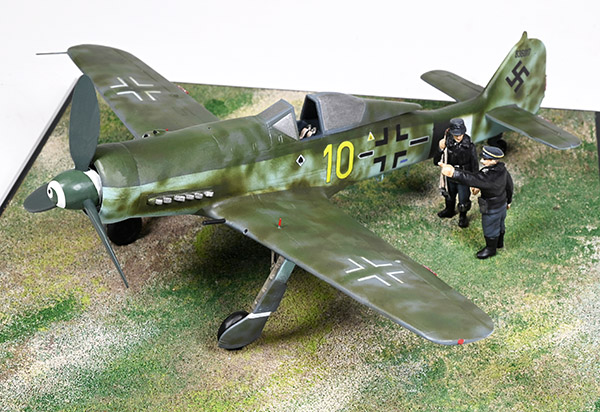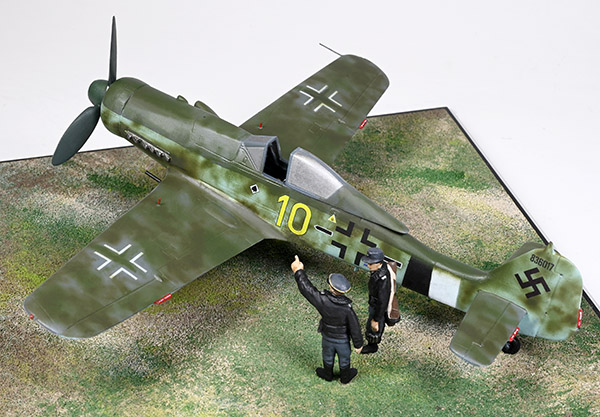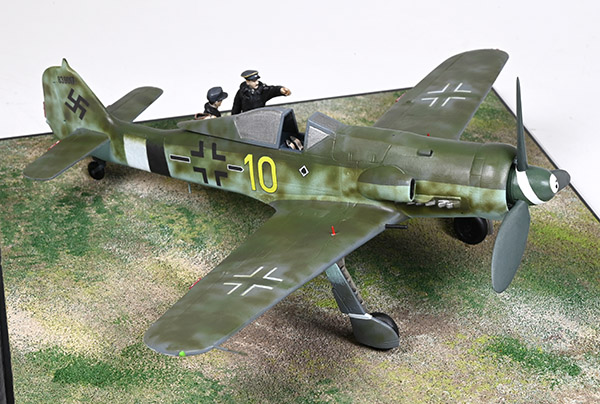Focke Wulf Fw 190D-13/R11
Focke Wulf Fw 190D-13/R11 ‘Yellow 10’ Werk Nr. 836017
Major Franz Gotz, Kommodore of JG 26, May 1945
The Focke-Wulf Fw 190D (“Dora”), which entered service in autumn 1944, was the last variant of Kurt Tank’s Fw 190 to see service in considerable numbers. References cite that between 650 and 700 “Doras” were built before the occupation of Focke-Wulf factories by Allied forces brought production to an end.
Early in development, Tank began addressing the limitations, at higher altitude, of the original BMW radial-engined Fw 190A. The main issue with the radial power plant was its poor performance above 23,000ft. In the long-nosed Fw 190D variant, the BMW 801 radial unit of earlier types was superseded by a Junkers Jumo 213 liquid cooled in-line engine driving a three-bladed “paddle” propeller. A supercharger powered mechanically by the engine and water-methanol injection aided further improvements to performance. These power plant changes resulted in an aircraft with a top speed of 426mph and a service ceiling of 43,000ft.
These “long-nosed” Focke-Wulfs, “D-models,” also had a stretched aft fuselage to maintain the location of the fighter’s centre of gravity.Armament comprised two 20mm MG 151 cannons in the wings and another firing through the spinner. A 1,102lb bomb could be carried on a centreline ventral rack or alternatively a 300l drop tank to extend flying time.
The “Dora” could out-climb and out-dive its BMW radial-powered predecessor with ease, and it possessed an excellent turning rate at speed. An experienced pilot could pull a tighter turn in a Fw 190D than he could with the Fw 190A. Many who flew the Fw 190D considered it one of the finest propeller-driven fighters available to the Luftwaffe, showing comparable performance with the Spitfire XIV and Mustang P-51D.However, Germany’s lack of well-trained pilots and shortage of fuel at the late stages of the war made the new Fw 190 D a less than effective weapon.
‘Yellow 10’ was the 17th D-13 manufactured and delivered to JG 26 It is almost certain that it was the personal aircraft of Major Franz Gotz, Kommodore of JG 26. The title ‘Kommodore’ is even present below the chin. Because of his former affiliation with JG 53 as II Gruppenkommandeur, he put the ‘Pik As’, ace of spades emblem beneath the cockpit. “Yellow 10” was captured by the Canadians at Flensburg at war’s end. Oberst Heinz Lange, the Kommodore of JG 51 who flew D-9s was asked by the RCAF in June 1945, with Gunther Josten also of JG 51, to fly this advanced fighter against the hawker Tempest in mock combat. Fw. Gerhard Kroll flew D-9s with III./JG 54 as top cover for Kommando Nowotny’s Me 262s. After Nowotny’s death, Kroll was assigned to home defense. III./JG 54 became IV./JG 26 on February 1945, the unity flying D-9s and D-13s. In May of 1945, and ‘Yellow 10’ was surrendered to the Allies and shipped to Freeman Airfield, Indiana, for evaluation. It was the only Fw 190 D-13 to have survived the war. Later it was given to Georgia Institute of Technology and then passed through several private owners before being acquired by Doug Champlin in 1972.
In 2001, Gosshawk Unlimited completed a thorough restoration on this rarest of aircraft. ‘Yellow 10’ was acquired subsequently by the Flying Heritage & Combat Armor Museum in 2007. It will never be flown due to it being the only one of its type left in the world.
Scale 1:48 Wingspan 8.61″ (219 mm)
Base size 9.33″ (237 mm) square (No. 6)
Weight not including base 1lb 7ozs (652 grams)
Limited edition of 10 only
SOLD OUT




